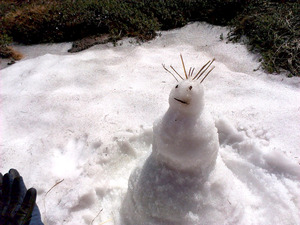ELSI Blog
74 A Geoscientist at ELSI: Initially a "Black Sheep", Now a Team Member
 Japan has almost become my second "home". On April 1, 2014, I came to Japan for the 10th time. It was Prof. Shige Maruyama, a world known geoscientist, who first invited me to Tokyo Tech in 2004. In total, I have been to the Tokyo Tech's Earth & Planetary Science Dept. 7 times, but usually for short stays of 1-2 months. This is the first time I came to stay much longer, 10 months, as a researcher of ELSI funded by the JSPS Invitation Program. But I have known Prof. Maruyama, my inviter, host and true "sensei", since 1998, when he came to my home Institute of Geology and Mineralogy in Novosibirsk (Russia) to participate in field works in the Russian Altai and Kazakhstan. The topic of our joint research program is "Asia: a frontier for a future supercontinent Amasia".
Japan has almost become my second "home". On April 1, 2014, I came to Japan for the 10th time. It was Prof. Shige Maruyama, a world known geoscientist, who first invited me to Tokyo Tech in 2004. In total, I have been to the Tokyo Tech's Earth & Planetary Science Dept. 7 times, but usually for short stays of 1-2 months. This is the first time I came to stay much longer, 10 months, as a researcher of ELSI funded by the JSPS Invitation Program. But I have known Prof. Maruyama, my inviter, host and true "sensei", since 1998, when he came to my home Institute of Geology and Mineralogy in Novosibirsk (Russia) to participate in field works in the Russian Altai and Kazakhstan. The topic of our joint research program is "Asia: a frontier for a future supercontinent Amasia".
The main idea is that studying the last 300 Ma geological history of Asia would provide us a clue for understanding what will happen to the "continental mosaic" of the Earth in 100 to 200 Ma from now. This is of key importance for understanding the evolution of Life on the Earth, which definitely depends on the temperature of the mantle, the volume of continental crust and the major events of assembly and breakup of supercontinents driven by plate tectonics. At 300 Ma ago or so, several huge continental masses collided to form what we call now "Central Asian Orogenic Belt" (CAOB), the world's largest accretionary orogen, which I have been studying during the last 10 years. The CAOB was a place of major crustal growth on the Earth during the whole Phanerozoic, i.e. the last 540 Ma, and still is the most remarkable feature of the Asian continent. The understanding of the process of continental growth in the CAOB is the main goal of UNESCO-IUGS International Geological Correlation Program (IGCP)#592, which I am a leader of (http://igcp592.igm.nsc.ru/ ).
We are unravelling a puzzle of continental growth in Asia through Pacific-type orogeny by discussing its tectonic history and geological structure, subduction polarity, tectonic erosion of continental crust and subduction of island arcs at convergent margins, generation of mantle plumes, and prospects of Asia, a nucleus of a future supercontinent, growth and overgrowth. The processes of continental growth depend on those in the deep mantle, at both the core-mantle boundary and in the mantle transition zone. The importance of crustal growth comes from the understanding that the formation of continental crust on Early Earth created a favorable environment for the origin of life and pre-determined its further evolution.
It has been a challenge for me to get adapted to a dominantly non-geological environment of ELSI. ELSI gave me a unique opportunity to go outside of my professional "comfort zone" by attending seminars on biology, astronomy and astrobiology and communicating with researchers from other fields, which all greatly broadened my horizons. As I am a geologist, initially I felt a bit like a "black sheep" in ELSI, surrounded by so many other scientists working on topics I knew relatively little about. However, they quickly welcomed me, which made me feel like a team member instead. I also appreciate all the ELSI staff for welcoming me warmly and helping me to get used to the "ELSI lifestyle". I value very much that on one hand, ELSI always responds to my requests and initiatives, but on the other hand ELSI does not intrude my common workflow of writing papers, analyzing samples and doing field works, which I am used to.
I like many things at ELSI, but most of all I like the idea of the Communication Room, which is REALLY for communication, like the many seminars on different topics, the Fridays "izakayas", which helped me to know the ELSI people better. Many thanks to Shio Watanabe for everyday help with organizational paperwork, travel arrangements and figure drawings, to Reiko Hattori for help in planning the research schedule, to Sayaka Price for Japanese classes, for John and Christine Hernlund, who extended a helping hand when I was feeling almost lost during the first weeks, and to the always ready-to-help ladies from the Administration Office.











